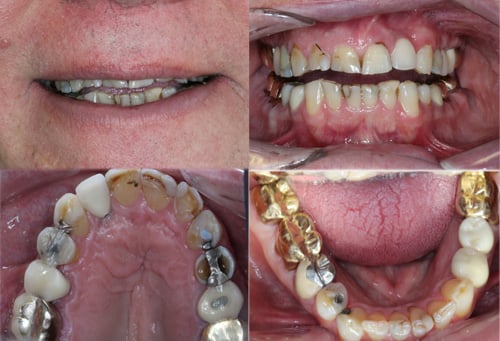- Office Hours Mon - Fri 9:00 am – 4:00 pm EST
So one of the questions that I’ve asked myself, is are my patients understanding what I’m saying when they don’t get to see what I see? And I feel like this is something that we all fall into: we love to talk and try to educate, but the patient’s not having the same visual as we do. So how do we overcome that?
First thing is to talk to them in their hygiene appointment, and make sure you get them to agree to come back in for an hour visit to give them a complete examination. At that appointment, we will go through all the examination and then take photos and other records. The four photos that I like to take are:
These four photos really give us a good overview of what’s going on in the mouth and then when you bring that up on the TV or a screen for them to view as well, it’s amazing how many times my patients say, “Are those my teeth? That’s really what my teeth look like?” And I’m like, “Yeah.” And then you can see the light bulb go off.
The time spent in this complete examination and then using these four photos can be critical.
 I also use an intra-oral camera in their hygiene appointments for diagnosing single-tooth issues. The problem with the intra-oral camera is you are only capturing one tooth at a time. It’s kind of like trying to see the forest when all you’re doing is taking pictures of individual trees.
I also use an intra-oral camera in their hygiene appointments for diagnosing single-tooth issues. The problem with the intra-oral camera is you are only capturing one tooth at a time. It’s kind of like trying to see the forest when all you’re doing is taking pictures of individual trees.
So keep that in mind when utilizing the intra-oral camera.
And so when I started to implement a one-hour visit and then implementing these four photos into my examination process and spending adequate time with them, educating them, helping them understand that I’m concerned about a few things of what I am seeing. And when they get to see it as well, the case acceptance has risen and they are much more open to the treatment and to the dentistry that’s going to help them have long-term success.
I hope this helps you in achieving overall great oral health for your patients.
To learn more about patient communication and case acceptance, register for the online program with Dr. Paul Homoly, Making it Easy for Patients to Say Yes.
Monday – Friday:
9:00 am – 4:00 pm EST
Phone:
727.823.7047
We firmly believe that the internet should be available and accessible to anyone, and are committed to providing a website that is accessible to the widest possible audience, regardless of circumstance and ability.
To fulfill this, we aim to adhere as strictly as possible to the World Wide Web Consortium’s (W3C) Web Content Accessibility Guidelines 2.1 (WCAG 2.1) at the AA level. These guidelines explain how to make web content accessible to people with a wide array of disabilities. Complying with those guidelines helps us ensure that the website is accessible to all people: blind people, people with motor impairments, visual impairment, cognitive disabilities, and more.
This website utilizes various technologies that are meant to make it as accessible as possible at all times. We utilize an accessibility interface that allows persons with specific disabilities to adjust the website’s UI (user interface) and design it to their personal needs.
Additionally, the website utilizes an AI-based application that runs in the background and optimizes its accessibility level constantly. This application remediates the website’s HTML, adapts Its functionality and behavior for screen-readers used by the blind users, and for keyboard functions used by individuals with motor impairments.
If you’ve found a malfunction or have ideas for improvement, we’ll be happy to hear from you. You can reach out to the website’s operators by using the following email
Our website implements the ARIA attributes (Accessible Rich Internet Applications) technique, alongside various different behavioral changes, to ensure blind users visiting with screen-readers are able to read, comprehend, and enjoy the website’s functions. As soon as a user with a screen-reader enters your site, they immediately receive a prompt to enter the Screen-Reader Profile so they can browse and operate your site effectively. Here’s how our website covers some of the most important screen-reader requirements, alongside console screenshots of code examples:
Screen-reader optimization: we run a background process that learns the website’s components from top to bottom, to ensure ongoing compliance even when updating the website. In this process, we provide screen-readers with meaningful data using the ARIA set of attributes. For example, we provide accurate form labels; descriptions for actionable icons (social media icons, search icons, cart icons, etc.); validation guidance for form inputs; element roles such as buttons, menus, modal dialogues (popups), and others. Additionally, the background process scans all of the website’s images and provides an accurate and meaningful image-object-recognition-based description as an ALT (alternate text) tag for images that are not described. It will also extract texts that are embedded within the image, using an OCR (optical character recognition) technology. To turn on screen-reader adjustments at any time, users need only to press the Alt+1 keyboard combination. Screen-reader users also get automatic announcements to turn the Screen-reader mode on as soon as they enter the website.
These adjustments are compatible with all popular screen readers, including JAWS and NVDA.
Keyboard navigation optimization: The background process also adjusts the website’s HTML, and adds various behaviors using JavaScript code to make the website operable by the keyboard. This includes the ability to navigate the website using the Tab and Shift+Tab keys, operate dropdowns with the arrow keys, close them with Esc, trigger buttons and links using the Enter key, navigate between radio and checkbox elements using the arrow keys, and fill them in with the Spacebar or Enter key.Additionally, keyboard users will find quick-navigation and content-skip menus, available at any time by clicking Alt+1, or as the first elements of the site while navigating with the keyboard. The background process also handles triggered popups by moving the keyboard focus towards them as soon as they appear, and not allow the focus drift outside of it.
Users can also use shortcuts such as “M” (menus), “H” (headings), “F” (forms), “B” (buttons), and “G” (graphics) to jump to specific elements.
We aim to support the widest array of browsers and assistive technologies as possible, so our users can choose the best fitting tools for them, with as few limitations as possible. Therefore, we have worked very hard to be able to support all major systems that comprise over 95% of the user market share including Google Chrome, Mozilla Firefox, Apple Safari, Opera and Microsoft Edge, JAWS and NVDA (screen readers), both for Windows and for MAC users.
Despite our very best efforts to allow anybody to adjust the website to their needs, there may still be pages or sections that are not fully accessible, are in the process of becoming accessible, or are lacking an adequate technological solution to make them accessible. Still, we are continually improving our accessibility, adding, updating and improving its options and features, and developing and adopting new technologies. All this is meant to reach the optimal level of accessibility, following technological advancements. For any assistance, please reach out to
ADA CERP is a service of the American Dental Association to assist dental professionals in identifying quality providers of continuing dental education. ADA CERP does not approve or endorse individual courses or instructors, nor does it imply acceptance of credit hours by boards of dentistry.
Concerns or complaints about a CE provider may be directed to the provider or to the Commission for Continuing Education Provider Recognition at ADA.org/CERP.